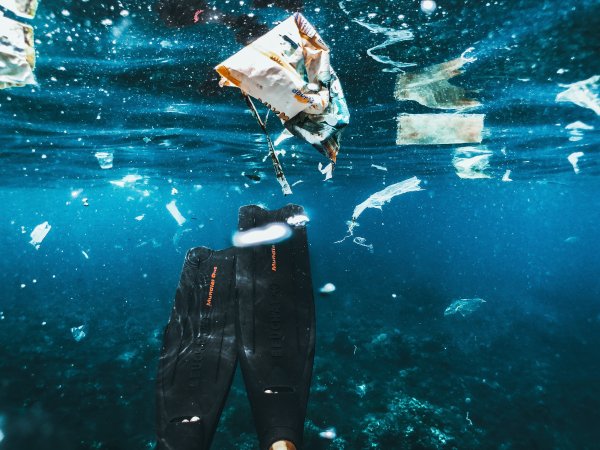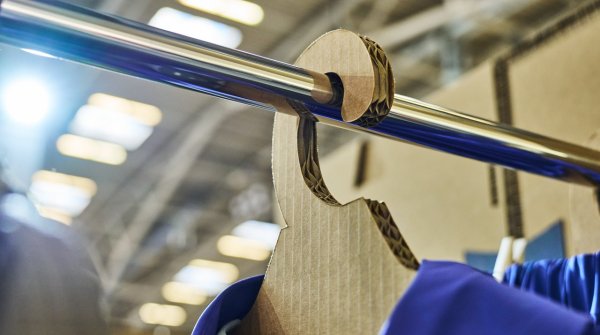From the Mariana Trench in the Western Pacific to Mount Everest - microplastics are everywhere. It comes mainly from industrial waste, disposable products and packaging that can break down into small pieces. Trillions of particles float in the world's oceans, larger portions of them in a growing carpet of plastic that wafts across the ocean.
About two thirds of all textiles are made from synthetic, petroleum-based polyester, polyamide and acrylic. According to Ademe (French Agency for Ecological Change), 60.5 million tons of new polyester were produced worldwide in 2021, releasing 240,000 tons of microplastic particles into the environment. Fiber fragments are increasingly attacking biodiversity and public health. Exemplary players in the textile industry are therefore taking concrete action to improve the situation.
From 2024, fashion or eco-labeling will be compulsory in France and could soon apply to the whole of Europe. Via a QR code, which must be affixed both to the labels of the garments and to the labeling of the points of sale, information on the release risk of microfibers, hazardous product components and the assessment of recyclability can be viewed - a first step towards more transparency.
Water pollution from plastic waste and microplastics is complex and multidimensional. Microplastics are defined by UNEP (United Nations Environment Protection) and ECHA (European Chemicals Agency) as small plastic fragments measuring five millimeters or less. Nanofibers are one-dimensional, fibrous materials with diameters in the range of 10 to 100 nanometers. However, it applies to more than one plastic and its fiber size. Even though the term "microfiber" is often used to describe a thread made from a synthetic source, such as polyester, the term microfiber applies to both synthetic and natural fibers. Sophie Mather, co-founder of the Microfiber Consortium, comments: "There is a different understanding of these terms. The Microfibre Consortium does not specify the size or type in this context. To avoid this confusion, fiber fragment or fiber fragmentation is the preferred terminology."
It is not only the microplastics themselves that cause problems. Often the fiber fragments still carry chemical residues from dyeing or impregnation, which even in the case of natural fibers complicate or prevent biodegradability and in the worst case have a toxic effect. According to the Paris Good Fashion Movement. "microfiber shedding occurs at almost every stage of a garment's life cycle and causes harm to people and the environment."
This means that with each wash and even with each wear the fabrics are involuntarily worn out. The losses depend on various parameters and conditions. There are three main phases: Production, use and end of life. The origin of the fabric, the manufacturing practices, the dyeing process and the water treatment determine the quality of the fabric and therefore the life of the garment. The type and frequency of washing, both upfront in the industry and later in the home, also have an impact.
Microplastics are even produced during the processing of recycled fibers. The amount depends, among other things, on the temperatures, the recycling process (chemical, mechanical or physical) or the water supply. So even with recycled fabrics, proper handling from production to end-of-life is important if you want to reduce microfiber losses. In most cases, chemical recycling processes provide better fabric quality.
Unfortunately, even materials from a different use, e.g. yarns from PET bottles or blended fabrics, are not an endless source for recycling. Blends of synthetic and natural materials are also difficult to recycle again. Their disposal is not yet adequately regulated. They often end up as fuels. So even a closed-loop economy cannot prevent fiber fragmentation. At best, a closed-loop system helps to reduce dependence on petroleum-based materials.
There are ways to counteract fiber loss. Some consortia and institutions are supporting the textile and outdoor industry: "Investigating ways to reduce microfiber pollution in the fashion industry using innovations in textile design and production" is the subtitle of From the Future 's latest report on microfiber pollution.
A step in the right direction would be, for example, the development of a joint roadmap and a continuous, scientifically based study with the Microfibre Consortium. Optimizations would be possible in materials and yarns as well as in manufacturing processes, such as
- alternative tanning
- circular, regenerative fibers (algae, bio-based)
- bioplastics
- man-made cellulose fibers microplastic-free closed-loop chemical recycling processes (Infinity Fiber).
All of these alternatives are worth considering with a systemic and holistic approach, science-based goal setting, and LCA (life cycle analysis).
Another milestone of the transformation is to fill the narrative of change with life. Some brands are already very active in this regard. In 2020, Georgia Parker, Fashion for good Innovation Manager, revealed, "67 companies say sustainable sourcing is a priority for them." The pace of innovation has accelerated, spurred by a shift in price and issue awareness, as well as the removal of barriers to accessing project finance.
Adidas™, for example, plans to completely eliminate the use of pure polyester by 2024. The Patagonia™ brand, known for its climate sensitivity, has similar goals for 2025. In collaboration with the Microfibre Consortium, Adidas stated, "The challenge of fiber fragmentation can only be addressed if our industry comes together and works on solutions."
Another decisive factor: Good ideas must be made popular. Respect Ocean therefore honors the best innovations separately, for example with the "Special Award for the Conservation of Marine Biodiversity," the "Special Award for Bioinspired Solutions" or the "Special Award for Early Stage Solutions."
One example: the Hong Kong Research Institute of Textiles and Apparel has developed a process for separating microplastic fibers. Accusweep™ from KHrita is suitable for treating textile wastewater, among other applications. The system uses an acoustic manipulation technique to separate microplastic fibers in water.
In addition to a common understanding of the problem, brands, producers and suppliers also hope for help from legislation. In February 2023, a number of NGOs (Surf Rider, Rethink Plastic, etc.) sent a letter to the REACH Committee (Registration, Evaluation, Authorization and Restriction of Chemicals) of the European Union for this reason. Their request: a restriction of micro- and nanoplastics in all non-essential uses.
According to a report by the Economist Impact think tank and the Nippon Foundation, which recently launched the ocean conservation initiative Back to Blue, "Annual global plastic production in G20 countries could rise to 451 million tons by 2050 at current growth rates."
Across the ocean, in Copenhagen, the Global Fashion Agenda proclaims that the fashion industry can lead the transition to a circular system while safely or even increasing its value creation by
- Reusing and recycling products and materials,
- creating new opportunities for innovative design,
- encouraging greater customer engagement.
However, the measures described show: overproduction must be tackled, especially in (ultra) fast fashion models. This is because the problem of microfibers cannot be solved by recycling or circular flows alone. Only a combination of many measures can provide a remedy. And all those involved must pull together, on one fiber.
Subscribe to our newsletters to stay up to date and don't miss the interview with Sophie Mather, co-founder of the Microfibre Consortium™.
- ISPO awards
- Mountain sports
- Bike
- Design
- Retail
- Fitness
- Health
- ISPO Job Market
- ISPO Munich
- ISPO Shanghai
- Running
- Brands
- Sustainability
- Olympia
- OutDoor
- Promotion
- Sports Business
- ISPO Textrends
- Triathlon
- Water sports
- Winter sports
- eSports
- SportsTech
- OutDoor by ISPO
- Heroes
- Transformation
- Sport Fashion
- Urban Culture
- Challenges of a CEO
- Trade fairs
- Sports
- Find the Balance
- Product reviews
- Newsletter Exclusive Area
- Magazine






